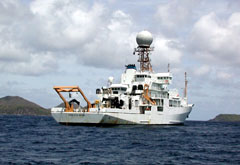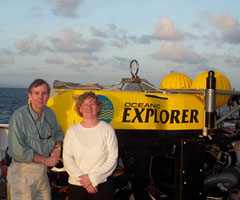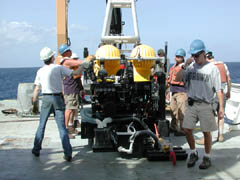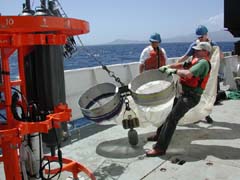| NOAA Magazine || NOAA Home Page |
NOAA AND NASA COLLABORATE THROUGH TEACHER AT SEA
 April
9, 2003 — How does space exploration parallel ocean exploration?
What kind of technology is used in both? These are questions NASA educator
Brian Hawkins will address when he talks to teachers and students about
his recent experiences aboard the NOAA oceanographic research ship RONALD
H. BROWN as a NOAA Teacher at Sea. Hawkins is the first NASA teacher
to participate in the NOAA program and
hopes this initial partnership will set the stage for future collaboration
between the two science agencies. (Click image for larger view
of NOAA Ship RONALD H. BROWN sitting almost directly over the submarine
volcano Kick ‘em Jenny more than 4 miles off the coast of Grenada
in the Caribbean. Please credit "NOAA.")
April
9, 2003 — How does space exploration parallel ocean exploration?
What kind of technology is used in both? These are questions NASA educator
Brian Hawkins will address when he talks to teachers and students about
his recent experiences aboard the NOAA oceanographic research ship RONALD
H. BROWN as a NOAA Teacher at Sea. Hawkins is the first NASA teacher
to participate in the NOAA program and
hopes this initial partnership will set the stage for future collaboration
between the two science agencies. (Click image for larger view
of NOAA Ship RONALD H. BROWN sitting almost directly over the submarine
volcano Kick ‘em Jenny more than 4 miles off the coast of Grenada
in the Caribbean. Please credit "NOAA.")
The NOAA Teacher at Sea program was established about 12 years ago as a way to give kindergarten through college teachers an opportunity to get hands-on research experience aboard NOAA oceanographic, fisheries, and hydrographic survey ships. Teachers can get an up-close view of the world of marine and atmospheric science and the type of research experience that many don’t have. Their enthusiasm and knowledge is then passed to their students, perhaps sparking interest in pursuing careers in science. Many teachers who have taken advantage of the program have indicated that the experience was life and career enhancing, giving them much more insight into how research is conducted and a greater appreciation of the environment and the need to protect it.
 Hawkins
is part of a corps of educators under NASA’s Aerospace Education
Services Program, which is administered by Oklahoma State University.
AESP provides assistance
and support to educators in updating science, mathematics, geography,
and technology curricula and in utilizing new and evolving instructional
technology and teaching strategies. Hawkins works with teachers and students
of all ages in his assigned territory of Washington state and Alaska,
under the aegis of NASA’s Ames Research Center in Ames, Calif. His
many years of diverse experience prepared him well for the NASA program;
he has taught at middle and high schools and the University of Alaska,
and given professional aviation flight instruction. (Click NOAA
image for larger view of NASA educator Brian Hawkins and Debby Kay, from
NOAA Research and marine mammal observer for the cruise, aboard the NOAA
ship RONALD H. BROWN. Click here
for high resolution version, which is a large file. Please credit “NOAA.”)
Hawkins
is part of a corps of educators under NASA’s Aerospace Education
Services Program, which is administered by Oklahoma State University.
AESP provides assistance
and support to educators in updating science, mathematics, geography,
and technology curricula and in utilizing new and evolving instructional
technology and teaching strategies. Hawkins works with teachers and students
of all ages in his assigned territory of Washington state and Alaska,
under the aegis of NASA’s Ames Research Center in Ames, Calif. His
many years of diverse experience prepared him well for the NASA program;
he has taught at middle and high schools and the University of Alaska,
and given professional aviation flight instruction. (Click NOAA
image for larger view of NASA educator Brian Hawkins and Debby Kay, from
NOAA Research and marine mammal observer for the cruise, aboard the NOAA
ship RONALD H. BROWN. Click here
for high resolution version, which is a large file. Please credit “NOAA.”)
Hawkins heard about the NOAA Teacher at Sea program while attending a
conference of the National Science Teachers Association, and was able
to attend a Teacher at Sea presentation at the conference.
“It seemed like a logical joining of both our education outreach programs in earth science,” Hawkins said, “and for me in particular as I do a lot of oceanography training for teachers at NASA. We have a variety of educational projects with NASA’s earth science enterprise.”
 With
the help of Janice Svien of NOAA Marine
and Aviation Operations, which administers the Teacher at Sea program,
Hawkins identified a cruise that fit his interests and was an excellent
tie-in to NASA. The NOAA ship RONALD H. BROWN was scheduled to conduct
research and surveys of the Kick ‘em Jenny undersea volcano west
of Grenada—a collaborative project of the Seismic Research Unit
of the University of the West Indies,
the University of Rhode Island,
and NOAA. The project, funded by the NOAA
Office of Ocean Exploration, included multi-beam sonar mapping of
the volcano, seismic profiling, video observations and sample collections
using a remotely operated vehicle (ROV), measurements of hydrothermal
activity, sediment core collection, and biological sampling. (Click
NOAA image for larger view of ROV being prepared for launch from the NOAA
ship RONALD H. BROWN. Click here
for high resolution version, which is a large file. Please credit “NOAA.”)
With
the help of Janice Svien of NOAA Marine
and Aviation Operations, which administers the Teacher at Sea program,
Hawkins identified a cruise that fit his interests and was an excellent
tie-in to NASA. The NOAA ship RONALD H. BROWN was scheduled to conduct
research and surveys of the Kick ‘em Jenny undersea volcano west
of Grenada—a collaborative project of the Seismic Research Unit
of the University of the West Indies,
the University of Rhode Island,
and NOAA. The project, funded by the NOAA
Office of Ocean Exploration, included multi-beam sonar mapping of
the volcano, seismic profiling, video observations and sample collections
using a remotely operated vehicle (ROV), measurements of hydrothermal
activity, sediment core collection, and biological sampling. (Click
NOAA image for larger view of ROV being prepared for launch from the NOAA
ship RONALD H. BROWN. Click here
for high resolution version, which is a large file. Please credit “NOAA.”)
“The recent Kick ‘em Jenny cruise provided an opportunity for the ship to support the Teacher at Sea program in a new way by hosting a teacher from a unique group of educators who work for NASA,” said Capt. John Wilder, NOAA, commanding officer of RONALD H.BROWN. “Brian Hawkins came to the ship in San Juan and immediately established himself as an interested and involved member of the scientific party. He immersed himself in both the ship and scientific perspective of the operation. While platforms or packages were being deployed or retrieved, Brian was there to photograph, inquire, and participate. Likewise, when the resulting data were being analyzed by the scientific party, he seemed captivated in his inquisitiveness and desire to understand.”
Hawkins was especially interested in the work of the ROV and use of robotics for the undersea study, because he could tie them into NASA’s educational Web site called Quest. Quest is currently featuring a design contest for robotics. Hawkins sent some students in Trinidad a NASA CD-ROM dealing with virtual exploration and mapping, and turned them onto the daily work of the BROWN through Web postings of principal investigator John Shepherd of the University of the West Indies.
“We were looking at robotics on the ship; NASA uses them in the International Space Station. With one in outer space, and one in innerspace—the world of the ocean—there is a nice parallel. NASA is also sending robots to Mars to study volcanoes. Students were able to make the connection of the use of robotics in a variety of environments. I hope to get them interested in science and continue their study of robotics with NASA and NOAA,” Hawkins said.
He expects to continue to use these tools for online learning with students in the United States as well as incorporate what he’s experienced into other presentations in oceanographic and earth sciences. He’s done this through work with the Naval Undersea Museum and the Jason Project, among others. “I will use Teacher at Sea to integrate NOAA and NASA in standard-based lessons in teacher training activity,” Hawkins said. “The major emphasis is teacher training, education reform, and systemic change in math and science.”
 One
of his jobs is to help inspire young people who are looking at career
options, so Hawkins spent a lot of his time on BROWN with the crew, discussing
their jobs and how they apply to practical science. “I was particularly
impressed with the professionalism and dedication of the NOAA
Corps officers,” he said. “It was an opportunity to spend
some time with them on a one-on-one basis. After the research was over,
I came back to port with the crew and had more time to talk about career
aspirations and how they were able to incorporate their love of the sea
into a career.” (Click NOAA image for larger view of deck
crew and scientists pulling up bongo nets used to sample sea life during
the cruise around the volcano. l-r Leukemia Mounce (student from University
of Virgin Islands), Jonathan Shannahoff, the chief survey technician on
the RONALD H. BROWN, and Andrew Staroscik (Univ. of Rhode Island). Click
here for high resolution version, which is a large file. Please credit
“NOAA.”)
One
of his jobs is to help inspire young people who are looking at career
options, so Hawkins spent a lot of his time on BROWN with the crew, discussing
their jobs and how they apply to practical science. “I was particularly
impressed with the professionalism and dedication of the NOAA
Corps officers,” he said. “It was an opportunity to spend
some time with them on a one-on-one basis. After the research was over,
I came back to port with the crew and had more time to talk about career
aspirations and how they were able to incorporate their love of the sea
into a career.” (Click NOAA image for larger view of deck
crew and scientists pulling up bongo nets used to sample sea life during
the cruise around the volcano. l-r Leukemia Mounce (student from University
of Virgin Islands), Jonathan Shannahoff, the chief survey technician on
the RONALD H. BROWN, and Andrew Staroscik (Univ. of Rhode Island). Click
here for high resolution version, which is a large file. Please credit
“NOAA.”)
Hawkins found the most gratifying part of the cruise was to be able to participate in real-time discovery. “To see, with the scientists, new features never before seen on this planet was really exciting,” he said. “I also participated with NOAA and the universities at a news conference, where we were able to present the discoveries to the public in a way to help them better understand the volcano and its interaction with their community.”
Though Hawkins has had previous experience with research and oceanography, many of his AESP colleagues have not. He hopes the Teacher at Sea program will become an ongoing relationship between NOAA and NASA. “We have many individuals who are excellent teachers but don’t have a strong background in ocean science. This is an opportunity to give them professional development and see how a 24-hour mission is conducted, either in space or undersea. It gives them credibility with other teachers and research experience they’ve never had.”
NOAA is dedicated to enhancing economic security and national safety through the prediction and research of weather and climate-related events and providing environmental stewardship of the nation’s coastal and marine resources. NOAA is part of the Department of Commerce.
Relevant
Web Sites
NOAA Teacher at Sea Program
NOAA Office of Ocean Exploration
NOAA Marine and Aviation Operations
Media
Contact:
Jeanne
Kouhestani, NOAA Marine and Aviation
Operations, (301) 713-3431 ext. 220
(Photos courtesy
of Debby Kay of NOAA Research.)